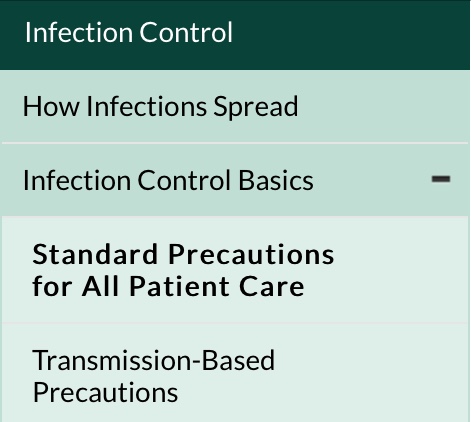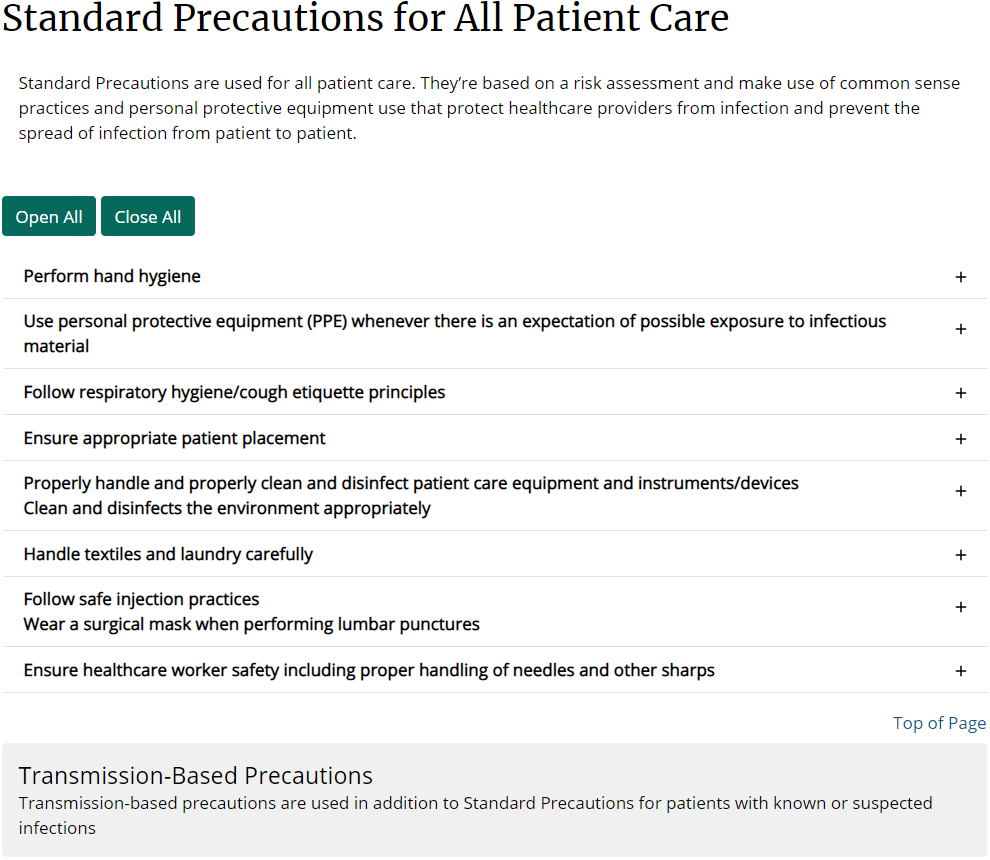
Standard Precautions are the minimum infection prevention practices that apply to all patient care, regardless of suspected or confirmed infection status of the patient, in any setting where health care is delivered. Standard Precautions include —

- Hand hygiene.
- Use of personal protective equipment (e.g., gloves, masks, eyewear).
- Respiratory hygiene / cough etiquette.
- Ensure appropriate patient placement
- Properly handle and properly clean and disinfect patient care equipment and instruments/devices.
- Cleans and disinfects the environment appropriately.
- Handle textiles and laundry carefully.
- Follow Safe injection practices.
- Ensure healthcare worker safety including proper handling of needles and other sharps
Hand Hygiene
Hand hygiene is the most important measure to prevent the spread of infections among patients and DHCP. Education and training programs should thoroughly address indications and techniques for hand hygiene practices before performing routine and oral surgical procedures.
- Website for Hand Hygiene
- Guideline for Hand Hygiene
- Training Course for Hand Hygiene
- Posters and Brochures for Hand Hygiene
Personal Protective Equipment
Personal protective equipment (PPE) refers to wearable equipment that is designed to protect from exposure to or contact with infectious agents. PPE that is appropriate for various types of patient interactions and effectively covers personal clothing and skin likely to be soiled with blood, saliva, or other potentially infectious materials (OPIM) should be available. These include gloves, face masks, protective eye wear, face shields, and protective clothing (e.g., reusable or disposable gown, jacket, laboratory coat). Examples of appropriate use of PPE for adherence to Standard Precautions include—
Use of gloves in situations involving possible contact with blood or body fluids, mucous membranes, non-intact skin (e.g., exposed skin that is chapped, abraded, or with dermatitis) or OPIM.
Use of protective clothing to protect skin and clothing during procedures or activities where contact with blood or body fluids is anticipated.
Use of mouth, nose, and eye protection during procedures that are likely to generate splashes or sprays of blood or other body fluids.
Respiratory Hygiene/Cough Etiquette
Respiratory hygiene/cough etiquette infection prevention measures are designed to limit the transmission of respiratory pathogens spread by droplet or airborne routes. The strategies target primarily patients and individuals accompanying patients who might have undiagnosed transmissible respiratory infections, but also apply to anyone with signs of illness including cough, congestion, runny nose, or increased production of respiratory secretions.
- Guideline for Isolation Precautions
- Respiratory Hygiene/Cough Etiquette in Healthcare Settings
- Cover Your Cough

Appropriate Patient Placement
Sterilization and Disinfection of Patient-Care Items and Devices
- Guidelines for Environmental Infection Control
- Guideline for Disinfection and Sterilization
- Toolkit Evaluating Environmental Cleaning
Recommendations for the cleaning, disinfection, and sterilization of medical equipment are available in the Guideline for Disinfection and Sterilization in Healthcare Facilities: https://www.cdc.gov/infectioncontrol/guidelines/disinfection/index.html
FDA regulations on reprocessing of single-use devices are available at: https://www.fda.gov/downloads/MedicalDevices/DeviceRegulationandGuidance/GuidanceDocuments/ucm071441.pdf
Handle Textiles and Laundry Carefully
Follow Safe Injection Practices
Safe injection practices are intended to prevent transmission of infectious diseases between one patient and another, or between a patient and healthcare professional.